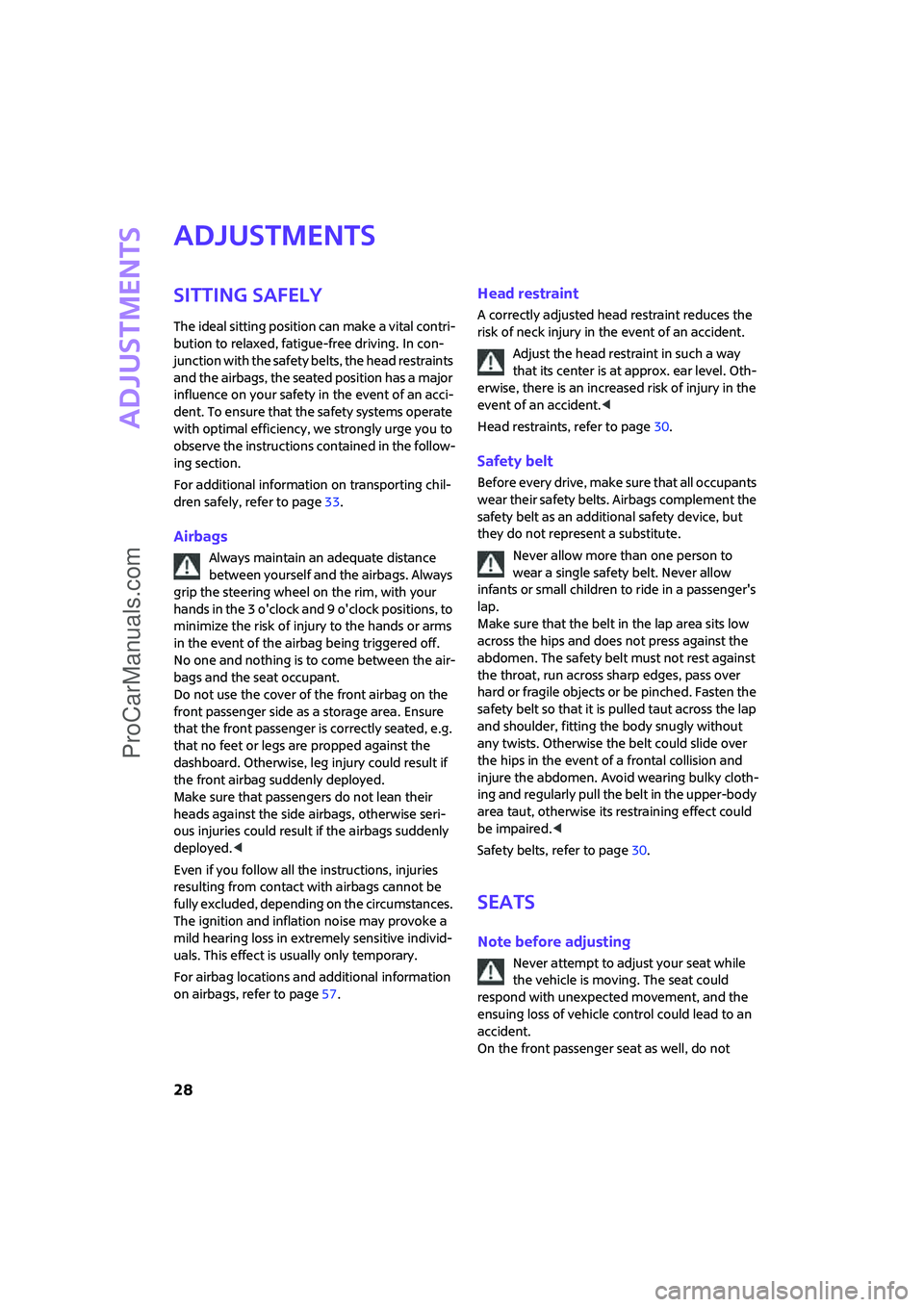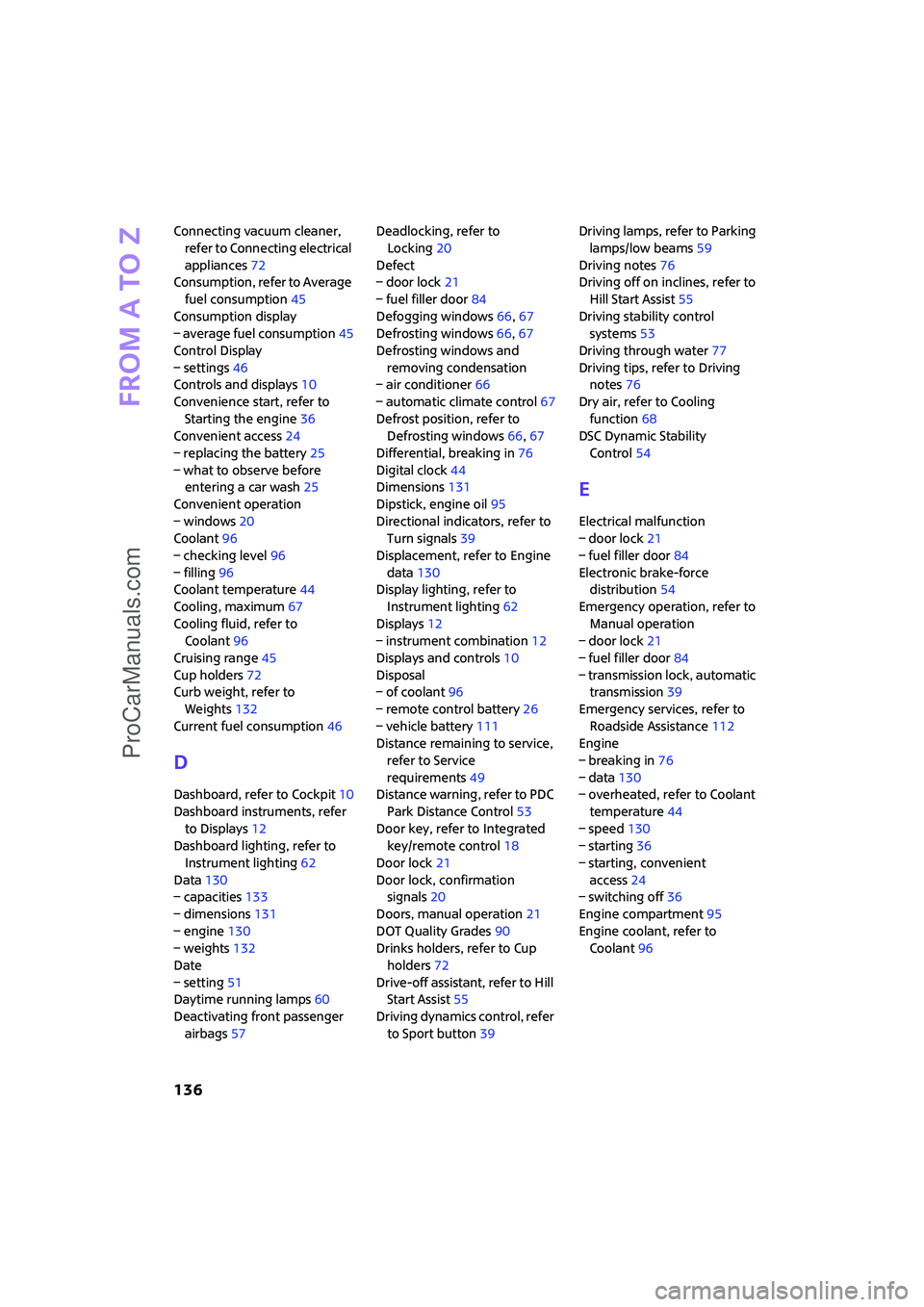dashboard MINI COOPER 2007 Owners Manual
[x] Cancel search | Manufacturer: MINI, Model Year: 2007, Model line: COOPER, Model: MINI COOPER 2007Pages: 148, PDF Size: 2.54 MB
Page 30 of 148

Adjustments
28
Adjustments
Sitting safely
The ideal sitting position can make a vital contri-
bution to relaxed, fatigue-free driving. In con-
junction with the safety belts, the head restraints
and the airbags, the seated position has a major
influence on your safety in the event of an acci-
dent. To ensure that the safety systems operate
with optimal efficiency, we strongly urge you to
observe the instructions contained in the follow-
ing section.
For additional information on transporting chil-
dren safely, refer to page33.
Airbags
Always maintain an adequate distance
between yourself and the airbags. Always
grip the steering wheel on the rim, with your
hands in the 3 o'clock and 9 o'clock positions, to
minimize the risk of injury to the hands or arms
in the event of the airbag being triggered off.
No one and nothing is to come between the air-
bags and the seat occupant.
Do not use the cover of the front airbag on the
front passenger side as a storage area. Ensure
that the front passenger is correctly seated, e.g.
that no feet or legs are propped against the
dashboard. Otherwise, leg injury could result if
the front airbag suddenly deployed.
Make sure that passengers do not lean their
heads against the side airbags, otherwise seri-
ous injuries could result if the airbags suddenly
deployed.<
Even if you follow all the instructions, injuries
resulting from contact with airbags cannot be
fully excluded, depending on the circumstances.
The ignition and inflation noise may provoke a
mild hearing loss in extremely sensitive individ-
uals. This effect is usually only temporary.
For airbag locations and additional information
on airbags, refer to page57.
Head restraint
A correctly adjusted head restraint reduces the
risk of neck injury in the event of an accident.
Adjust the head restraint in such a way
that its center is at approx. ear level. Oth-
erwise, there is an increased risk of injury in the
event of an accident.<
Head restraints, refer to page30.
Safety belt
Before every drive, make sure that all occupants
wear their safety belts. Airbags complement the
safety belt as an additional safety device, but
they do not represent a substitute.
Never allow more than one person to
wear a single safety belt. Never allow
infants or small children to ride in a passenger's
lap.
Make sure that the belt in the lap area sits low
across the hips and does not press against the
abdomen. The safety belt must not rest against
the throat, run across sharp edges, pass over
hard or fragile objects or be pinched. Fasten the
safety belt so that it is pulled taut across the lap
and shoulder, fitting the body snugly without
any twists. Otherwise the belt could slide over
the hips in the event of a frontal collision and
injure the abdomen. Avoid wearing bulky cloth-
ing and regularly pull the belt in the upper-body
area taut, otherwise its restraining effect could
be impaired.<
Safety belts, refer to page30.
Seats
Note before adjusting
Never attempt to adjust your seat while
the vehicle is moving. The seat could
respond with unexpected movement, and the
ensuing loss of vehicle control could lead to an
accident.
On the front passenger seat as well, do not
ProCarManuals.com
Page 138 of 148

From A to Z
136
Connecting vacuum cleaner,
refer to Connecting electrical
appliances72
Consumption, refer to Average
fuel consumption45
Consumption display
– average fuel consumption45
Control Display
– settings46
Controls and displays10
Convenience start, refer to
Starting the engine36
Convenient access24
– replacing the battery25
– what to observe before
entering a car wash25
Convenient operation
– windows20
Coolant96
– checking level96
– filling96
Coolant temperature44
Cooling, maximum67
Cooling fluid, refer to
Coolant96
Cruising range45
Cup holders72
Curb weight, refer to
Weights132
Current fuel consumption46
D
Dashboard, refer to Cockpit10
Dashboard instruments, refer
to Displays12
Dashboard lighting, refer to
Instrument lighting62
Data130
– capacities133
– dimensions131
– engine130
– weights132
Date
– setting51
Daytime running lamps60
Deactivating front passenger
airbags57Deadlocking, refer to
Locking20
Defect
– door lock21
– fuel filler door84
Defogging windows66,67
Defrosting windows66,67
Defrosting windows and
removing condensation
– air conditioner66
– automatic climate control67
Defrost position, refer to
Defrosting windows66,67
Differential, breaking in76
Digital clock44
Dimensions131
Dipstick, engine oil95
Directional indicators, refer to
Turn signals39
Displacement, refer to Engine
data130
Display lighting, refer to
Instrument lighting62
Displays12
– instrument combination12
Displays and controls10
Disposal
– of coolant96
– remote control battery26
– vehicle battery111
Distance remaining to service,
refer to Service
requirements49
Distance warning, refer to PDC
Park Distance Control53
Door key, refer to Integrated
key/remote control18
Door lock21
Door lock, confirmation
signals20
Doors, manual operation21
DOT Quality Grades90
Drinks holders, refer to Cup
holders72
Drive-off assistant, refer to Hill
Start Assist55
Driving dynamics control, refer
to Sport button39Driving lamps, refer to Parking
lamps/low beams59
Driving notes76
Driving off on inclines, refer to
Hill Start Assist55
Driving stability control
systems53
Driving through water77
Driving tips, refer to Driving
notes76
Dry air, refer to Cooling
function68
DSC Dynamic Stability
Control54
E
Electrical malfunction
– door lock21
– fuel filler door84
Electronic brake-force
distribution54
Emergency operation, refer to
Manual operation
– door lock21
– fuel filler door84
– transmission lock, automatic
transmission39
Emergency services, refer to
Roadside Assistance112
Engine
– breaking in76
– data130
– overheated, refer to Coolant
temperature44
– speed130
– starting36
– starting, convenient
access24
– switching off36
Engine compartment95
Engine coolant, refer to
Coolant96
ProCarManuals.com